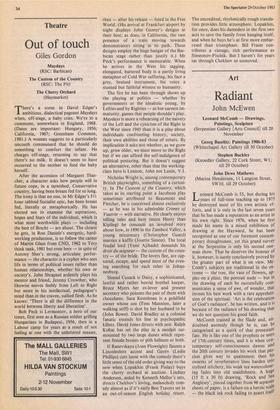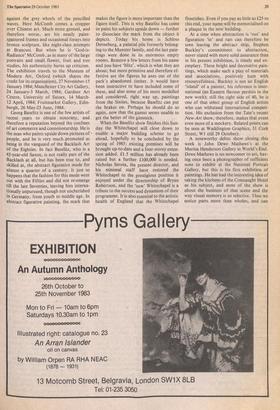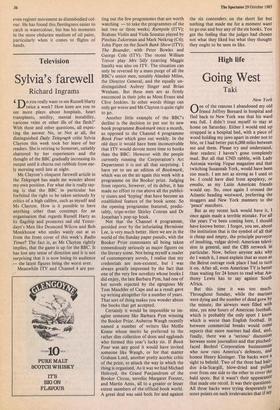Art
Radiant
John McEwen
Leonard McComb — Drawings, Paintings, Sculpture (Serpentine Gallery [Arts Council] till 20 November
Georg Baselitz: Paintings 1906-83 (Whitechapel Art Gallery till 30 October)
Stephen Buckley (Knoedler Gallery, 22 Cork Street, WI, till 29 October) John Dewe Mathews (Marina Henderson, 11 Langton Street, SW10, till 29 October)
Leonard McComb is 53, but during his years of full-time teaching up to 1975 he destroyed most of his own artistic ef- forts, and it is only in the last seven years that he has made a reputation as an artist in his own right. Since 1976, when he first made his name in a mixed exhibition of drawing at the Hayward, he has been recognised as one of our foremost contem- porary draughtsmen, yet this grand survey at the Serpentine is only his second one- man show. That he deserves the honour of it, however, is surely conclusively proved bY the greater part of what is on view. MC Comb's subjects are traditional in the ex- treme — the tree, the vase of flowers, ap- ples on a plate, the portrait nude — but in the drawing of each he successfully com- municates a sense of awe, of wonder, that invests his best work with a rare apprehen- sion of the spiritual. 'Art is the celebration of God's radiance', he has written, and it is because of the radiance of his drawing that we do not question his good faith.
McComb trained at the Slade and, un- doubted anomaly though he is, can be categorised as a quirk of that protestant fate. He is like one of the prophets or seers of 17th-century times, and it is when cos' temporary self-consciousness dawns and the 20th century invades his work that paS- sion gives way to quaintness; then his swarms of reverberative lines harden into
stylised stitchery, his weak tea watercolouring fades into old maidishness. A huge (15 ft x 30 ft) drawing, 'Rock and Sea Anglesey', pieced together from 96 separate sheets of paper, is a failure on a heroic scale — the black ink rock failing to assert itself
against the grey whorls of the pencilled waves. Here McComb comes a cropper over Chinese art. Much more genteel, and therefore worse, are his neatly paint- spattered frames and occasional forays into bronze sculpture, like night-class attempts at Brancusi. But when he is 'God-is- Radiance' McComb, as in many of the large portraits and small flower, fruit and tree studies, his authenticity burns up criticism. The exhibition travels to the Museum of Modern Art, Oxford (which shares the credit for its organisation), 27 November-15 January 1984; Manchester City Art Gallery, 24 January-3 March, 1984; Gardner Art Centre, University of Sussex, 14 March- 12 April, 1984; Fruitmarket Gallery, Edin- burgh, 26 May-23 June, 1984.
Georg Baselitz is one of the few artists of recent years to obtain notoriety, and therefore a reputation beyond the confines of art commerce and connoisseurship. He is the man who paints upside down pictures of People, and he is very much promoted as being in the vanguard of the Backlash Art of the Eighties. In fact Baselitz, who is a 45-year-old Saxon, is not really part of the Backlash at all, but has been true to, and skilled at, the abstract figurative mode for almost a quarter of a century. It just so happens that the fashion for this mode went out with the Fifties and did not re-emerge till the late Seventies, leaving him interna- tionally unpursued, though not uncherished in Germany, from youth to middle age. In abstract figurative painting, the mark that makes the figure is more important than the figure itself. This is why Baselitz has come to paint his subjects upside down — further to dissociate the mark from the object it depicts. Today his home is Schloss Derrieburg, a palatial pile formerly belong- ing to the Minister family, and the last pain- tings were done in its enormous empty rooms. Remove a few letters from his name and you have 'blitz', which is what they are about; but more primitive and therefore ef- fective are the figures he axes out of the park's abandoned timber. It would have been instructive to have included some of these, and also some of his more modelled and considered, right way up, paintings from the Sixties, because Baselitz can put the brakes on. Perhaps he should do so again, now that the gamut seems unable to get the better of the gimmick.
When the Baselitz show finishes this Sun- day the Whitechapel will close down to enable a major building scheme to go ahead, hopefully to be concluded by the spring of 1985: existing premises will be brought up-to-date and a four-storey exten- sion added. £1.5 million has already been raised but a further £100,000 is needed. Nicholas Serota, the present director, and his minimal staff have restored the Whitechapel to the prestigious position it enjoyed under the directorship of Bryan Robertson, and the 'new' Whitechapel is a tribute to the success and dynamism of their programme. It is also essential to the artistic health of England that the Whitechapel
flourishes. Even if you pay as little as £25 to this end, your name will be memorialised on a plaque in the new building. '
At a time when abstraction is 'out' and figuration 'in' and rats can therefore be seen leaving the abstract ship, Stephen Buckley's commitment to abstraction, never stated with more solid assurance than in his present exhibition, is timely and ex- emplary. These bright and decorative pain- tings, which make such a play of materials and associations, positively hum with resourcefulness. Buckley is not an English 'island' of a painter, his reference is inter- national (an Eastern flavour persists in the new work); still the right side of 40, he is one of that select group of English artists who can withstand international competi- tion. His exclusion from the Tate's recent New Art show, therefore, makes that event even more of a mockery. Related prints can be seen at Waddington Graphics, 31 Cork Street, WI (till 29 October).
A noteworthy debut show closing this week is John Dewe Mathews's at the Marina Henderson Gallery in World's End. Dewe Mathews is no newcomer to art, hav- ing once been a photographer of sufficient note to exhibit at the National Portrait Gallery, but this is his first exhibition of paintings. He has had the interesting idea of taking the kitchens of the Connaught Hotel as his subject, and most of the show is about the business of that scene and the way visual memory is so selective. Thus we notice parts more than wholes, and can even register movement as disembodied col- our. He has found this fleetingness easier to catch in watercolour, but has his moments in the more obdurate medium of oil paint, particularly when it comes to flights of hands.
















































 Previous page
Previous page